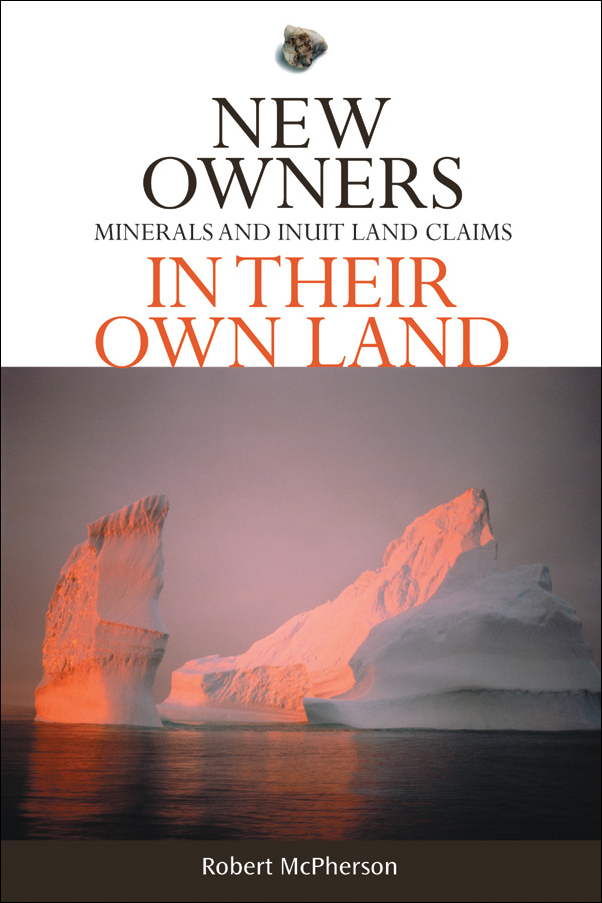
New Owners in Their Own Land: Minerals and Inuit Land Claims
Robert L. McPherson
$34.95 CAD / $39.95 USD
329 pages, 22 illustrations
6 x 9 inches
Paperback: 978-1-55238-155-7
January 2005
New Owners in their Own Land is a well-researched treatment of the institutional, political, and personal conflicts that guided the process of Nunavut land claim negotiations.
Robert McPherson carefully considers the connection between resource development stemming from the days of oil and gas exploration in the Arctic in the 1960s and the Inuit’s ensuing battle for self-determination. He outlines the federal government’s “business-as-usual” tactic in pushing exploration further north onto Inuit territory and sheds light on exactly how the precedent-settling agreement was achieved whereby the Inuit managed to become owners of the mineral claims on their own land.
New Owners in Their Own Land discusses the prolonged, historical dispute over the land selection process with respect to subsurface rights within Nunavut using existing research, interviews, and personal diaries. The author’s personal account of his involvement as a mineral consultant for the Inuit negotiators provides a rare and unique perspective on Inuit self-determination and exploration history in the North.
Robert McPherson is a research associate with the Arctic Institute of North America.
Abbreviations
Preface
Introduction
Keewatin Events
Economic Background
Rankin Inlet Nickel
The Nickel Mine’s Impact
Community Life
Effects of the Mine Closure in 1962
Central Keewatin Interaction and Leadership Growth
Relocation Events and Effects
Growth of Leadership and Advocacy
Exploration Pressures
Early Geological Exploration and Prospecting
Growth of Exploration in the 1960s
Native Responses to Explorationists and Their Allies
Keewatin Exploration Boom
Inuit Political Organization
Indian Eskimo Association (IEA)
The Founding of the Inuit Tapirisat of Canada (ITC)
Beginnings of COPE
The Berger Inquiry
Inuit Nunavut Proposal
Polar Gas Pipeline Responses
COPE Inuvialuit Nunangat Proposal
COPE Agreement-in-Principle
Gathering Sense of Unified Action
Caribou Aboriginal Rights Case
The Nanisivik Mine
Introduction
Early History
Exploration and Pre-Development of the Mine
Social Environment
Feasibility Study Contacts
Negotiating the Agreement
Token Consultation and ITC Conflict
Native Employment
A Future for the Inuit
Final Agreement
Mine Performance
Inuit Employment Study
Inuit Work Record
Personal Attitudes
Results of the Study
Ongoing Policy
The Future
Aftermath of Nanisivik
The Road to Nunavit
A Singular Proposal by the ITC and Its Aftermath
Land Claim Negotiations
Emergence of the Tungavik Federation of Nunavut
Some Feedback to Developers
The Western Arctic Claim: The Inuvialuit Final Agreement
Land-Claim Negotiations are Stepped Up
The Coolican Report and More Negotiations
Putting the Land in Land-Claim Negotiations
At Last, an Agreement-in-Principle
Exploration Presses On
Calming the Waters
A Buoyant but Changing Industry
Some Inuit Responses
Uranium Development Projects Make News
The Effect of Land Claims on Exploration
Projects Under Native and Environmental Scrutiny
The Kiggavik Project Review Has its Detractors
Scoping Workshops and Aftermath
Gathering Opposition
EIS Fuels More Controversy
Baker Lake Rejects the Mine
UG Suspends the Kiggavik Project
Summation
New Owners
Agreement-in-Principle at Last
Personal Note
Organizing the Team
Prep Work and Philosophy
Thoughts on Subsurface Quantum
Meeting with Inuit in Workshops
Negotiations Begin at Pond Inlet
Subsurface Becomes Contentious
Compromise Begins, in Part
Mineral Issues Unresolved
Personal Impressions
Negotiations Continue at Pangnirtung
Photos
Breakthrough at Resolute Bay
Negotiations Continue at Coral Harbour
Maps
Negotiations Break Down at Rankin Inlet
Negotiators Try Again at Rankin Inlet
Negotiations Conclude at Coppermine
Land Base Achieved
Summation
Concluding Note
Notes
Inded
Fascinating and accessible
—Martina Tyrrell, Études/Inuit/Studies
A “must read” for explorationists and history buffs.
—Lionel C. Kilburn, Arctic
Provides much factual detail on highly significant events in the recent history of resource exploitation and Inuit rights within the North.
—Raymond J. Towse, British Journal of Canadian Studies